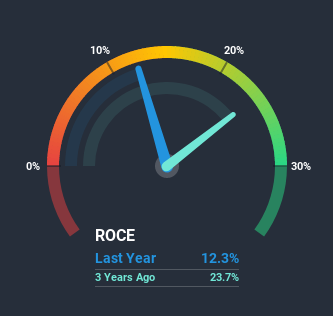- United Kingdom
- /
- Consumer Durables
- /
- LSE:TW.
Should We Be Excited About The Trends Of Returns At Taylor Wimpey (LON:TW.)?

If you're looking for a multi-bagger, there's a few things to keep an eye out for. Firstly, we'd want to identify a growing return on capital employed (ROCE) and then alongside that, an ever-increasing base of capital employed. Basically this means that a company has profitable initiatives that it can continue to reinvest in, which is a trait of a compounding machine. In light of that, when we looked at Taylor Wimpey (LON:TW.) and its ROCE trend, we weren't exactly thrilled.
What is Return On Capital Employed (ROCE)?
If you haven't worked with ROCE before, it measures the 'return' (pre-tax profit) a company generates from capital employed in its business. The formula for this calculation on Taylor Wimpey is:
Return on Capital Employed = Earnings Before Interest and Tax (EBIT) ÷ (Total Assets - Current Liabilities)
0.12 = UK£552m ÷ (UK£5.5b - UK£1.0b) (Based on the trailing twelve months to June 2020).
Therefore, Taylor Wimpey has an ROCE of 12%. In absolute terms, that's a satisfactory return, but compared to the Consumer Durables industry average of 10% it's much better.
See our latest analysis for Taylor Wimpey

Above you can see how the current ROCE for Taylor Wimpey compares to its prior returns on capital, but there's only so much you can tell from the past. If you'd like, you can check out the forecasts from the analysts covering Taylor Wimpey here for free.
What Can We Tell From Taylor Wimpey's ROCE Trend?
We weren't thrilled with the trend because Taylor Wimpey's ROCE has reduced by 29% over the last five years, while the business employed 45% more capital. However, some of the increase in capital employed could be attributed to the recent capital raising that's been completed prior to their latest reporting period, so keep that in mind when looking at the ROCE decrease. The funds raised likely haven't been put to work yet so it's worth watching what happens in the future with Taylor Wimpey's earnings and if they change as a result from the capital raise.
On a related note, Taylor Wimpey has decreased its current liabilities to 18% of total assets. So we could link some of this to the decrease in ROCE. What's more, this can reduce some aspects of risk to the business because now the company's suppliers or short-term creditors are funding less of its operations. Since the business is basically funding more of its operations with it's own money, you could argue this has made the business less efficient at generating ROCE.Our Take On Taylor Wimpey's ROCE
From the above analysis, we find it rather worrisome that returns on capital and sales for Taylor Wimpey have fallen, meanwhile the business is employing more capital than it was five years ago. Long term shareholders who've owned the stock over the last five years have experienced a 21% depreciation in their investment, so it appears the market might not like these trends either. With underlying trends that aren't great in these areas, we'd consider looking elsewhere.
If you want to continue researching Taylor Wimpey, you might be interested to know about the 2 warning signs that our analysis has discovered.
For those who like to invest in solid companies, check out this free list of companies with solid balance sheets and high returns on equity.
If you’re looking to trade Taylor Wimpey, open an account with the lowest-cost* platform trusted by professionals, Interactive Brokers. Their clients from over 200 countries and territories trade stocks, options, futures, forex, bonds and funds worldwide from a single integrated account. Promoted
Valuation is complex, but we're here to simplify it.
Discover if Taylor Wimpey might be undervalued or overvalued with our detailed analysis, featuring fair value estimates, potential risks, dividends, insider trades, and its financial condition.
Access Free AnalysisThis article by Simply Wall St is general in nature. It does not constitute a recommendation to buy or sell any stock, and does not take account of your objectives, or your financial situation. We aim to bring you long-term focused analysis driven by fundamental data. Note that our analysis may not factor in the latest price-sensitive company announcements or qualitative material. Simply Wall St has no position in any stocks mentioned.
*Interactive Brokers Rated Lowest Cost Broker by StockBrokers.com Annual Online Review 2020
Have feedback on this article? Concerned about the content? Get in touch with us directly. Alternatively, email editorial-team@simplywallst.com.
About LSE:TW.
Taylor Wimpey
Operates as a homebuilder company in the United Kingdom and Spain.
Flawless balance sheet and undervalued.
Similar Companies
Market Insights
Community Narratives





